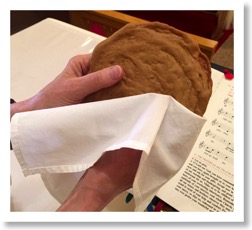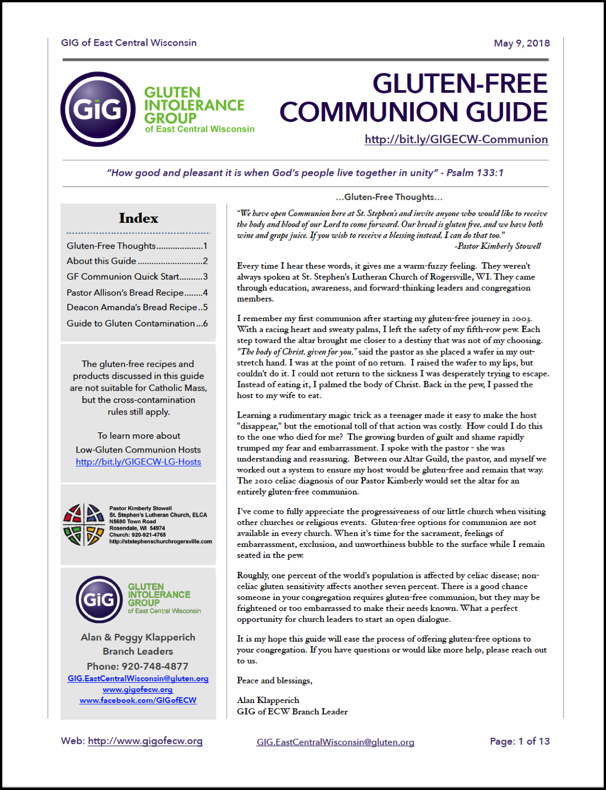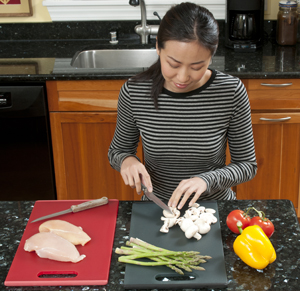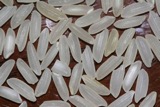Gluten-Free Communion Guide

Attention to detail is critical for success in the gluten-free lifestyle. It is not surprising considering lives are turned upside-down by something measured in parts per million [yes, parts per million].
Please keep an open mind about the information presented here. It can be hard to comprehend that "The Staff of Life" can make someone sick. Science proves it to be true for about 3 million with celiac disease and an estimated 17 million with gluten sensitivities; just in the USA alone.
In this guide, you'll find information on gluten, how to eliminate gluten cross-contact, several recipes for gluten-free hosts, and links to commercially available gluten-free hosts.
If you have questions or desire additional help in instituting a gluten-free communion in your house of worship, please reach out to us.
Alan & Peggy Klapperich
Gluten Intolerance Group of East Central Wisconsin
GIG.EastCentralWisconsin@gluten.org
Phone: 920-748-4877

Guide to Gluten Cross Contamination

Separate - Don't Contaminate!
Basic kitchen safety rules tell us that we need to separate ready-to-eat foods from raw meats, poultry, seafood, and eggs - and to use separate cutting boards and utensils to reduce the risk of food poisoning.
The same rules apply to gluten and gluten-free foods - they must be kept apart.
Even though a recipe may use gluten-free ingredients, the food must be appropriately prepared, so it remains gluten-free. If you are making meals for a gluten-free guest, you must be mindful of gluten cross-contact.
This guide will help you to understand and prevent gluten cross-contamination.
Updated: May 2, 2018
Before you start you need to know a few basics.
What is gluten?
Where is gluten found?
What does gluten do?
Think of gluten as a poison. How much arsenic would you like in your food? Very good, I thought you'd say zero.
Not only must the food be gluten-free, but it also must not come in contact with any gluten.
The concept of “a crumb will hurt you” is hard for people to understand because it involves minuscule amounts.

Here's a perfect illustration. An average grain of rice weighs 28 milligrams. Now, divide that grain into 3 pieces. Those pieces are 9.33 milligram each – just under 10 mg limit.
Mind blown? There's more...
Many can not consume even 10 mgs of gluten without getting sick. Many in the gluten-free community strive for and attain ZERO gluten.
ZERO gluten should be the ultimate goal for everyone following a gluten-free diet.
Read more: http://bit.ly/GIGECW-Heat-Destruction
Double dipping is strictly prohibited. Master the fine art of “Gob Dropping” or using a couple of spoons & knives to accomplish the task.
Purchase squeezable containers when possible.
Same goes for stirring and serving. Always use a clean utensil for gluten-free foods.
Have dedicated utensils for only GF use.
Purchase and use new products. Dispose of contaminated products or clearly label as not gluten-free.
Do not boil gluten-free pasta in water that previously cooked gluten-full pasta. Use fresh water for GF pasta.
It's best to designate a gluten-zero prep area where no gluten is allowed.
Toaster bags are an option.
Toaster Ovens with Fixed racks – line with foil. Works well for heating, baking, but not good for toasting.
Toaster Ovens with Removable racks – purchase and mark new rack for GF use. Foil existing rack or clean.
Either turn off the convection feature (circulated air) or make sure you have a tight-fitting lid on your gluten-free dish.
Have dedicated GF cookie sheets.
Those living in a mixed house should have dedicated gluten-free utensils, cutting boards, colanders, etc. It helps to have them color coded. Consider using the color red for gluten-free.
Due to the holes in sponges, dedicate one to gluten-free.
Change them often.
If cleaning or replacing isn’t an option - grill gluten-free items on aluminum foil.
Have a marked & dedicated gluten-free chip dip bowl.
If no room for separate gluten-free/gluten-full foods, hold back some of the gluten-free foods before they are placed out for service. Tell your gluten-free guest where to find these items.
Invite gluten-free guests to go through the line first - before any of the gluten-free dishes have a chance to get contaminated.
Clean these items the best you possibly can - it's tough.
Gluten Intolerance Group of North America
http://bit.ly/GIG-NonDedKitchen
“A Day in the Life: Living in a Mixed House”
Gluten Intolerance Group of East Central Wisconsin
http://bit.ly/GIGECW_MixedHouse
“Gluten-Free Diet Boot Camp”
Gluten Intolerance Group of East Central Wisconsin
http://bit.ly/GIGECW_GFBootCamp
“Educating Family and Friends about Gluten-Free”
Gluten Intolerance Group of East Central Wisconsin
http://bit.ly/GIGECW_EducatingFamilyFriends
Store GF items in well marked, sealed containers.
Do not purchase food from bulk food bins. Highly contaminated.
Purchase only GF Certified grains & flours. Including oats - no commercial oats (think Quaker Oats).
Flour particles can remain airborne for up to 24 hours. Only prepare gluten-free foods after a thorough cleaning and before gluten foods.
A group of researchers from Immunogenx and Biomedal/Glutenostics recently published the results of their study - quantifying the amount of gluten being consumed by a selected group of patients with celiac disease. Indeed this was a first-of-its-kind, ground-breaking study. [See below for link to the actual study]
What did the study find?
People with celiac disease are inadvertently consuming more gluten than they realized.
Keep in mind, medical experts recommend gluten consumption be kept below 10 mg per day (a crumb approx. 1/3 of a grain of rice).
Participants were (on average) consuming between 15 and 40 times the recommended limit. 244 mg is approx. 8.5 grains of rice.
While these numbers might explain why an estimated 30% to 70% of celiac patients still experience celiac-related symptoms while following a gluten-free diet, it raises many more questions.
How much gluten is coming from cross-contamination?
Updated:
05/02/18 - Add Accidental Gluten Consumption Study & grammar clean up
01/28/18 - Added Gluten and the destruction by heat info
04/22/17 - Removed bad link.
04/29/15 - Added "A Day in the Life: Living in a Mixed House".
04/22/15 - Updated GIG links and updated Printer Friendly version.
01/31/15 - Added AllThingsGF.com Cross Contamination page link
06/21/14 - Add convection oven
12/27/13 - Fix broken links
10/20/2013 - Clarify terminology

